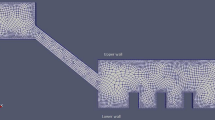Abstract
Groins are employed to prevent nearshore areas from erosion and to control the direction of flow. However, the groin structure and its associated flow characteristics are the main causes of local erosion. In this study, we investigate the flow patterns around refractive and right-angle groins. In particular, we analytically compare the flow characteristics around a refractive groin and study the degree of accuracy that can be achieved by using a right-angle groin of various projected lengths. To compare the flow characteristics, we replaced the right-angle groin with an approximation of a refractive groin. This replacement had the least effect on the maximum velocity of flow in the channel. Moreover, we investigated the distribution of the density variables of temperature and salinity, and their effects on the flow characteristics around the right-angle groin. A comparison of the flow analysis results in baroclinic and barotropic conditions reveals that the flow characteristic values are very similar for both the refractive and right-angle groins. The geometry of the groin, i.e., right-angle or refractive, has little effect on the maximum speed to relative average speed. Apart from the angular separation, the arm length of the groin in downstream refractive groins has less effect on other flow characteristics than do upstream refractive groins. We also correlated a number of non-dimensional variables with respect to various flow characteristics and groin geometry. These comparisons indicate that the correlation between the thalweg height and width of the channel and groin arm’s length to projection length have been approximated using linear and nonlinear formulas regardless of inner velocity in the subcritical flow.
Similar content being viewed by others
References
Blanckaert K, Duarte A, Schleiss AJ (2010). Influence of shallowness, bank inclination and bank roughness on the variability of flow patterns and boundary shear stress due to secondary currents in straight open-channels. Advances in Water Resources, 33(9), 1062–1074. DOI: 10.1016/j.advwatres.2010.06.012
Celic F, Ozden YA, Bal S (2014). Numerical simulation of the flow around two-dimensional partially cavitating hydrofoils. Journal of Marine Science and Application, 13(3), 245–254. DOI: 10.1007/s11804-014-1254-x
Coastal Engineering Research Center (1984). Shore protection manual. US Army Corps of Engineers, WES, Vicksburg, USA.
Darwish MS, Moukalled F (2003). TVD schemes for unstructured grids. International Journal of Heat and Mass Transfer, 46(4), 599–611. DOI: 10.1016/S0017-9310(02)00330-7
DHL (2011). Mike 21 & Mike 3 flow model FM. Hydrodynamic and transport module. Scientific documentation. DHL. Available from http://www.donpedrorelicensing.com/Lists/ Announcements/ Attachments/112/WAR-03_Attachment_C.pdf [Accessed on Jun. 06, 2014]
MIKE BY DHI (2011). MIKE 21 & MIKE 3 flow model. Softwares’ help. DHI, Horsholm, Denmark.
Giri S, Shimizu Y, Surajata B (2004). Laboratory measurement and numerical simulation of flow and turbulence in a meandering-like flume with spurs. Flow Measurement and Instrumentation, 15(5-6), 301–309. DOI: 10.1016/j.flowmeasinst.2004.05.002
Hentschel B, Anlauf A (2002). Ecological optimisation of groynes in the Elbe River. In: van Mazijk A, Weitbrecht V (Eds.). New Insights in the Physical and Ecological Processes in Groyne Fields. TUDelft/Universitat Karlsruhe, Delft, The Netherlands, 121–133.
Jawaher P, Kamath H (2000). A high-resolution procedure for Euler and Navier-Stokes computations on unstructured grids. Journal of Computational Physics, 164(1), 165–203. DOI: 10.1006/jcph.2000.6596
Kang JG, Yeo HK, Kim CS (2012). An experimental study on a characteristics of flow around groyne area by install conditions. Engineering, 4(10), 636–645. DOI: 10.4236/eng.2012.410081
Kang JG, Yeo HK, Kim SJ (2011). Experimental study on the flow characteristics around the refraction groyne. Engineering, 3(8), 842–850. DOI: 10.4236/eng.2011.38103
Lotfollahi Yaghin MA, Mojtahedi A, Ettefagh MM, Aminfar MH (2011). Experimental investigation of TARMAX model for modeling of hydrodynamic forces on cylinder-like structures. Journal of Marine Science and Application, 10(3), 281–288. DOI: 10.1007/s11804-011-1070-5
McCoy AW, Constantinescu G, Weber LJ (2007). Numerical investigations using LES: exploring flow physics and mass exchange processes near groynes. IIHR, College of Engineering, The University of Iowa, Iowa City, USA, IIHR Technical Report No. 461.
Ouillon S, Dartus D (1997). Three-dimensional computation of flow around groyne. Journal of Hydraulic Engineering, 123(11), 962–970. DOI: 10.1061/(ASCE)0733-9429(1997)123:11(962)
Peng J, Kawauara Y, Tamai N (1997). Numerical analysis of three-dimensional turbulent flows around submerged groins. 27th IAHR Congress, San Francisco, USA, 147–156.
Rajaratnam N, Nwachukwu BA (1983). Flow near groin-like structures. Journal of Hydraulic Engineering, 109(3), 463–480. DOI: 10.1061/(ASCE)0733-9429(1983)109:3(463)
Sea Angler (2011). Top tips for sea fishing against groynes. Available from http://www.gofishing.co.uk/Sea-Angler/ Section/how-to/Sea-Fishing-Advice/Fishing-Tips/Fishing-tips-a nd-tactics/Top-tips-for-sea-fishing-against-groynes/. [Accessed on Jun. 08, 2014].
Sleigh PA, Gaskell PH, Berzins M, Wright NG (1998). An unstructured finite-volume algorithm for predicting flow in rivers and estuaries. Computers & Fluids, 27(4), 479–508. DOI: 10.1016/S0045-7930(97)00071-6
Smagorinsky J (1963). General circulation experiments with the primitive equations. Monthly Weather Review, 91(3), 99–164. DOI: 10.1175/1520-0493(1963)0910099:GCEWTP2.3.CO;2
Tang XL, Chen ZC, Yang F (2006). Dynamic large eddy simulation of secondary flow near a groyne. International Journal of Nonlinear Sciences and Numerical simulation, 7(3), 257–262. DOI: 10.1515/IJNSNS.2006.7.3.257
Uijttewaal WSJ (2005). Effects of groyne layout on the flow in groyne fields: Laboratory experiments. Journal of Hydraulic Engineering, 131(9), 782–791. DOI: 10.1061/(ASCE)0733-9429(2005)131:9(782)
Uijttewaal WSJ, Lehmann D, van Mazijk A (2001). Exchange processes between a river and its groyne fields: Model experiments. Journal of Hydraulic Engineering, 127(11), 928–936. DOI: 10.1061/(ASCE)0733-9429(2001)127:11(928)
Wilcox DC (1994). Turbulence modeling for CFD. DCW Industries, Incorporated, La Canada, USA, 460.
Yeo HK, Kang JG, Kim SJ (2005). An experimental study on tip velocity and downstream recirculation zone of single groynes of permeability change. KSCE Journal of Civil Engineering, 9(1), 29–38. DOI: 10.1007/BF02829094
Zsugyel M, Tél T, Józsa J (2014). Numerical investigation of chaotic advection past a groyne based on laboratory flow experiment. Advances in Water Resources, 71, 81–92.
Author information
Authors and Affiliations
Corresponding author
Rights and permissions
About this article
Cite this article
Omdehghiasi, H., Mojtahedi, A. & Lotfollahi-Yaghin, M.A. Comparison of flow characteristics around refractive and right-angled groins in barotropic and baroclinic conditions. J. Marine. Sci. Appl. 14, 376–388 (2015). https://doi.org/10.1007/s11804-015-1330-x
Received:
Accepted:
Published:
Issue Date:
DOI: https://doi.org/10.1007/s11804-015-1330-x




